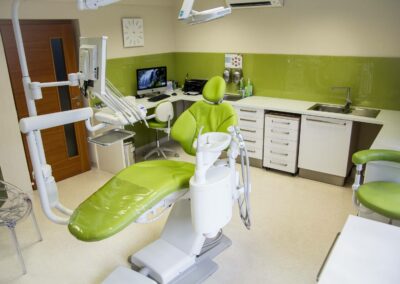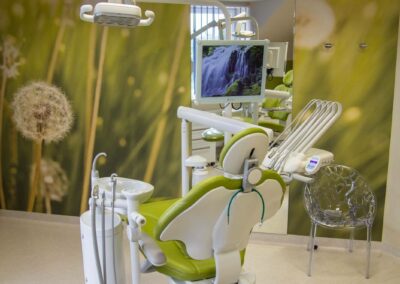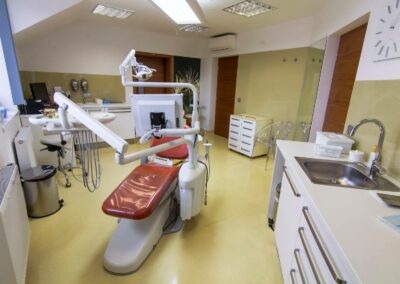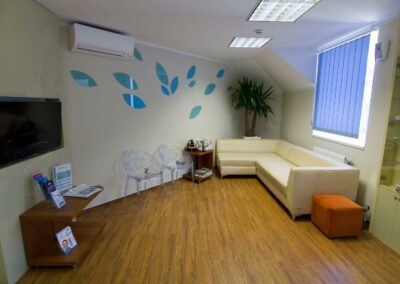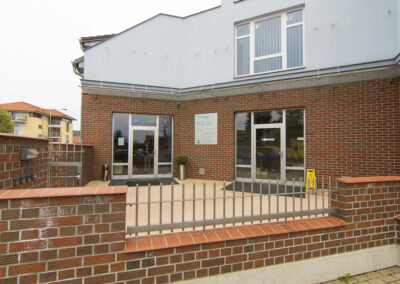Dental restorations
Dental restorations are used to replace missing teeth or to restore their original shape (function). Dental restorations are created outside the patient’s mouth on the basis of an impression. Dental restorations can be divided into two groups, depending on whether the restoration is removable or permanently attached in the mouth.
Types of restorations
1. Fixed dental restorations
This includes all restorations that are firmly fixed to teeth or implants. These are, in particular, aesthetic dental veneers, onlays, crowns, and bridges. Fixed restorations represent the best solution in terms of performance and aesthetics and in psychological terms.
Dental veneers
Dental veneers are used to replace the front surfaces of the teeth and are most often made of highly aesthetic ceramic material. With the help of dental veneers, we are able to improve the unsatisfactory shape and colour of the teeth, which is why these replacements are very popular in aesthetically demanding regions. These are thin and fragile ceramic replacements that do not gain the required strength until they are attached to the tooth. Veneers can also be made for teeth without prior grinding, but in most cases it is necessary to dissect away part of the hard dental tissue in order to ensure optimal conditions for making the replacement. Since this is an irreversible process, everything needs to be carefully planned in advance so that the patient is clear about the result even before the actual tooth reduction.
Before making the dental veneers, we have models created where the dental veneers are designed from wax. This work is consulted with the patient. We are primarily interested in whether the patient is satisfied with the shape of the teeth, or whether they would like to make some adjustments. Then we transfer this situation to the patient’s mouth using a temporary resin material to get a better idea of what the final work will look like. It should be noted that at this stage we have not yet performed any irreversible intervention on the teeth. We have good experience with the patient going home with the provisional restoration to get feedback from family and friends. We can’t start work unless we make sure that everyone is satisfied. The teeth are gently prepared, an impression is made, and the dental laboratory technician makes aesthetic dental veneers on the basis of the information obtained. These veneers are carefully fixed onto the teeth one by one and the result is fantastic.
Onlay
This is a modern dental restoration of the grinding teeth. The onlay is intended to restore the damaged tooth to its original shape and protect it from further damage. We can think of an onlay as a large white filling that is attached to the tooth to form one piece. It is made of ceramic or photocomposite material. The onlay covers the entire chewing surface of the tooth, which allows for an even distribution of masticatory forces, thus reducing the risk of cracking. Onlay is a type of replacement that is especially suitable for teeth where the root canals have been treated. The teeth stop being nourished by the pulp and become brittle. Such a tooth, combined with great chewing pressure, is at risk of developing a deep crack, which often leaves the doctor with no other option but to extract (pull out) the tooth. This is something to think about whenever a tooth is significantly weakened by an unsuitable filling or root canal filling.
Dental crowns
Dental crowns provide a thin protective shell that covers the entire crown part of the tooth, thus preventing it from being damaged. Dental crowns therefore primarily have a protective function. Like onlays, they are indicated after root canal treatment and to protect damaged teeth. With the help of dental crowns, we are also able to carry out more significant corrections of the colour and shape of the tooth in the aesthetic zone of the teeth. Dental crowns can be divided according to the material used into metal, resin, ceramic, and metal-ceramic ones.
Metal crowns
Metal crowns can be applied to the back teeth, where masticatory forces are strong. Crowns are not very aesthetic, so we do not recommend using them to treat teeth that can be seen when smiling and in normal conversation. They could unnecessarily attract unwanted attention. However, there is nothing to complain about in terms of their function.
Resin crowns
They have exactly the opposite properties to metal crowns. The aesthetic aspect is satisfactory, but resin crowns do not have sufficient resistance to withstand high masticatory forces for a long time. They are also more susceptible to colour changes and for this very reason they are only suitable as a long-term temporary solution.
Ceramic crowns
They have the best optical properties of all restorations, which is why the resulting aesthetic effect is very good. Ceramic crowns look natural and are often indistinguishable from your natural teeth. In addition, they are not as prone to discolouration or loss of lustre as other types of restorations. Therefore, they provide an ideal choice whenever we put crowns on the front teeth.
Metal-ceramic crowns
As the name suggests, these are a combination of two materials: metal and ceramic. A thin metal layer is fitted to the tooth to ensure mechanical resistance and strengthen the replacement. The ceramic layer then covers the entire surface of the crown and represents the aesthetic part of the dental restoration. Metal-ceramic crowns withstand chewing pressure very well and the resulting aesthetic impression is also very good, so they are a suitable type of replacement for back teeth. Since the dark thin metal rim can be seen in the neck area of the tooth, an all-ceramic crown is more suitable for front teeth.
Dental bridges
They allow us to replace a missing tooth and thus fill the gap created after its loss. The construction of a dental bridge resembles a traditional bridge. It consists of abutments and pontics. We can imagine that pillar abutments are like traditional dental crowns that are fixed onto reduced teeth. Bridge pontics are then used to connect the crowns. They have the shape of a natural tooth, and thus fill the space after its loss. Dental bridges, like crowns, are made of metal, resin, ceramic, or metal-ceramic.
2. Removable dental restorations
They allow us to replace missing teeth when a fixed dental restoration cannot be made. A typical example is the loss of back molars. A traditional dental bridge cannot be made in this case, because the last tooth on which the bridge would be anchored is missing. So we have two options to choose from. Replace missing back teeth with implants, or make a partial removable restoration. Removable restorations are usually cheaper, so they are mainly chosen for financial reasons.
Even with a perfectly fabricated removable dental restoration, it is necessary to consider that the function of the restoration is significantly reduced compared to your natural teeth. In other words, you have to really learn to eat and speak with the restoration.
As the name suggests, these restorations are not “fixed” in the mouth. Every evening, it is necessary to carefully clean the restorations of food residues and the coating that has formed on them during the day. Soap and a classic brush or toothbrush are sufficient for this purpose. After that, the restoration must be rinsed with water and stored in a dry place.
Even with total dentures, it is necessary to visit the dentist regularly for preventive check-ups. Although fake teeth cannot decay, regular inspection of the denture bed and adjustment of the denture are necessary for the correct functioning of the restoration.
Dental medical team
Assoc. Prof. Eva Gojišová, MD
chief doctor – dentistry
MUDr. Magdalena Koťová, Ph.D.
chief doctor – orthodontics
MUDr. Tomáš Hlaďo
specialist doctor – pediatric dentistry
MDDr. Petr Švácha
Dentist
MDDr. Martin Linka
specialist doctor – orthodontics
Contractual health insurance companies












